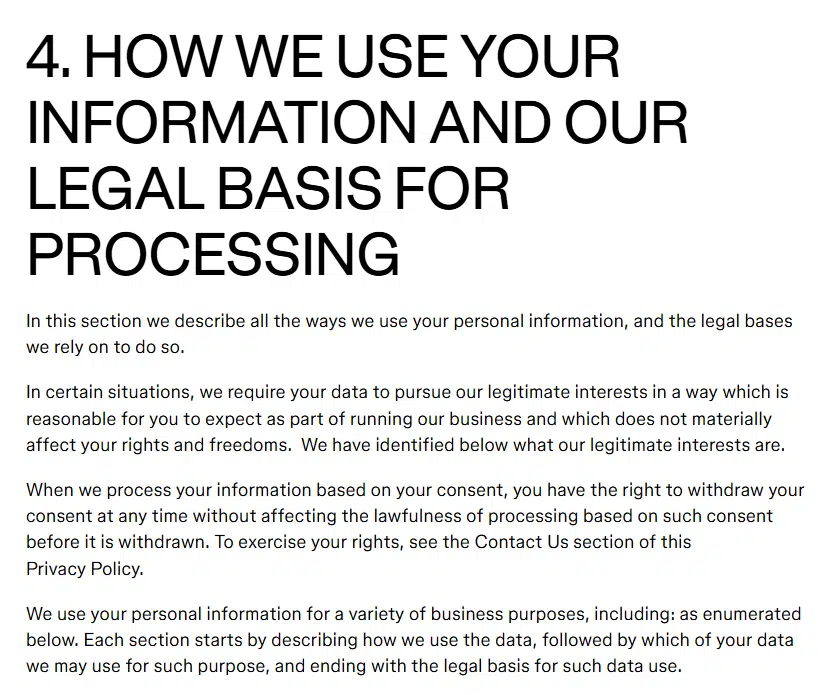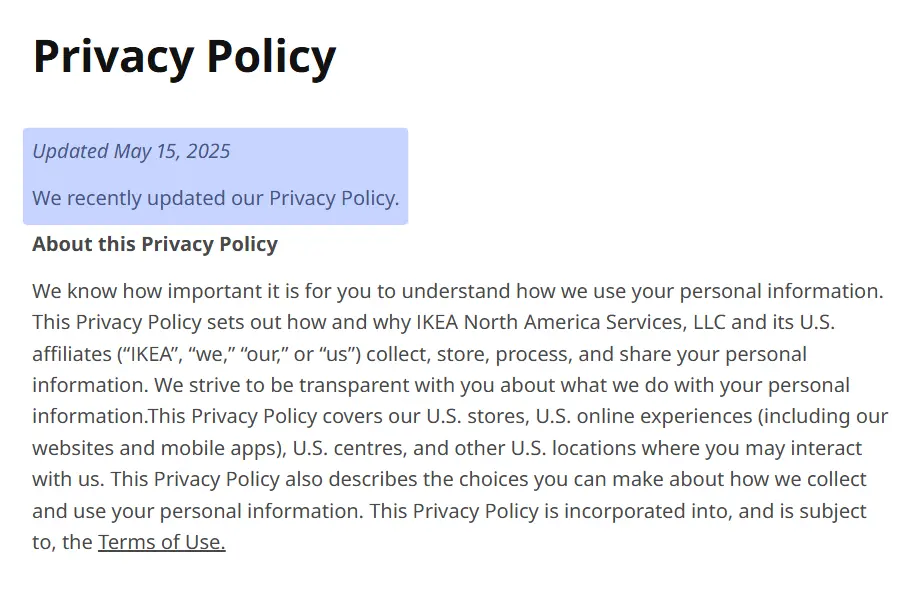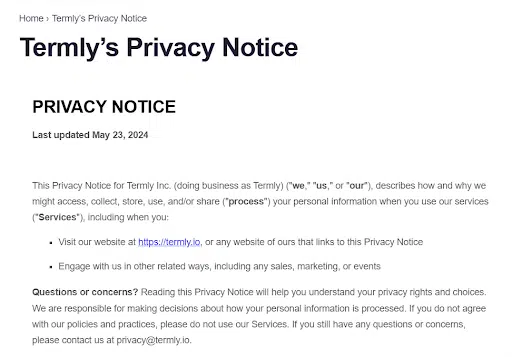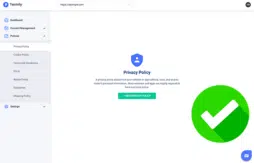Whether it’s vague wording, bad formatting, or missing information, a bad privacy policy can damage your credibility and put your business at risk.
In this guide, I walk you through some privacy policy red flags to avoid and show you what good policies do differently.
Top Privacy Policy Red Flags and How To Avoid Them
So, what exactly makes a privacy policy “bad”?
It’s not always about what’s in the policy. Sometimes, it’s what’s missing, what’s unclear, or how it’s presented.
Below are six of the most common red flags we encounter in privacy policies today, along with tips to help you address or avoid them altogether.
Red Flag #1: It’s Too Long, Too Short, or Hard To Read
Some privacy policies barely cover the basics, consisting of just a few vague sentences. Others go to the opposite extreme, piling on page after page of dense legal text with no breaks, clear structure, or regard for the reader’s experience.
Whether it’s too much, too little, or just plain hard to look at, these kinds of policies have one thing in common: they push readers away.
A policy that’s too short signals carelessness or an incomplete approach to privacy practices.
One that’s overly long or poorly formatted feels inaccessible, raising concerns about what might be hiding in the fine print.
Long, wordy, and difficult to read privacy policies are also considered a violation of privacy laws under the General Data Protection Regulation (GDPR). the California Consumer Privacy Act (CCPA), and others.
Why does this happen?
Some businesses might simply copy and paste privacy policy templates without tailoring them to their actual data collection practices.
Others may format their policies as static documents, like PDFs, without adapting them for web or mobile, leading to cramped layouts, small fonts, and unreadable sections.
If you plan to use a template, it’s essential to find one that’s both effective and customizable, enabling you to create a policy tailored to your business and understandable to users.
For example, Termly’s Privacy Policy Template is free to use, fully customizable and downloadable in various formats for your convenience.
What a good privacy policy looks like
A good privacy policy will strike a balance in size and amount of text, offering clear, structured content that’s long enough to cover what’s necessary but broken into manageable sections.
An excellent example of a privacy policy that does this well comes from Simple Mills, Inc. They present detailed information without overwhelming the reader.

Their policy is comprehensive enough to cover everything users need to know, including:
- What data is collected
- How it’s used
- Who it’s shared with
- What rights users have
They communicate this without resorting to unnecessary repetition or complex legal language.
The policy uses a clean layout with large, bolded section headings and a legible font size, making it easy to scan. Each section is broken into short paragraphs, which helps prevent reader fatigue and encourages users to engage with the content.
Red Flag #2: It Doesn’t Give Contact Information or Define Ownership
If a privacy policy doesn’t clearly state who it’s from or how to reach the business behind it, that’s a major transparency issue.
Users need to know who is collecting their data, who the policy applies to, and how they can get in touch with questions or concerns.
Why does this happen?
This red flag can stem from businesses treating privacy policies as one-size-fits-all documents.
Instead of customizing the content to reflect their specific operations, they might omit contact information altogether.
In other cases, companies may not realize that some data privacy laws require businesses to include contact details in their privacy policy, including the following:
- General Data Protection Regulation (GDPR)
- California Consumer Privacy Act (CCPA)/California Privacy Rights Act (CPRA)
- Personal Information Protection and Electronic Documents Act (PIPEDA)
- Other U.S. state laws
Failing to include contact information can put you out of step with these regulations and leave users frustrated or unable to act on their rights.
What a good privacy policy looks like
An effective privacy policy won’t leave users guessing who’s responsible for their data, instead, it will clearly:
- Name the business,
- Define the scope of the policy, and
- Offer a dedicated contact method, like an email address, phone number, or contact form.
For example, the United States Postal Service includes a dedicated section in its privacy policy titled “Where to Submit Inquiries,” which provides clear contact information for privacy-related questions or complaints.

The policy also explains that inquiries will be reviewed, responded to, and handled confidentially, demonstrating USPS’s commitment to transparency and accountability.
Red Flag #3: It Collects a Lot of Data (or is Very Vague)
It’s a red flag when businesses ask to collect too much unnecessary data in their privacy policy.
A privacy policy that claims to collect a list of every possible data type can come across as intrusive and excessive. It’s also potentially illegal.
Under the GDPR and U.S. state-level privacy laws, data controllers can only collect information that is necessary to achieve the purposes stated directly in the privacy policy.
Even worse, when a policy says something vague like, “We collect your information to improve our services,” users are left wondering what’s happening with their data.
A lack of clarity around why you’re collecting personal information can also risk noncompliance with laws like the GDPR and CCPA, which require businesses to explain the purpose of data collection in a manner that users can understand.
Why does this happen?
In some cases, businesses may try to cover their bases by including long lists of data types without actually tying them to specific uses.
Others might borrow language from a generic template or another website’s policy without reviewing whether it accurately reflects their practices.
It’s also possible businesses might not realize they legally are not authorized to collect as much data as they want just for the sake of it.
Either way, collecting too much data or being vague about your reasons why is a major privacy policy red flag.
What a good privacy policy looks like
Strong privacy policies list what data is collected in a clear format and also explain why it’s being collected.
For each category of information, it should provide the purpose clearly and, when necessary, reference the legal basis for the data processing.
A great example of a privacy policy that lists data well comes from Visa’s Global Privacy Notice, which outlines dozens of personal information categories, including:
- Transaction details
- Geolocation
- Biometric identifiers
- Inferred behavioral data

In addition to notifying users of these data collection types, they explain each purpose, from processing payments and detecting fraud, to fulfilling legal obligations and providing personalized services.
As a global payments company handling sensitive information, Visa has a clear responsibility to be transparent. Their level of specificity helps users understand exactly what’s collected and why, which is especially important for a company in their position.
Red Flag #4: It Contradicts Itself
A privacy policy that says one thing in one section and the opposite elsewhere creates confusion and erodes trust.
It feels misleading when one privacy policy section claims, “We don’t use personal data for marketing,” but another lists marketing cookies.
These kinds of contradictions suggest that the privacy approach is pieced together without careful review and might even suggest the policy is in violation of privacy laws
Why does this happen?
This can occur for several reasons. For example, when companies update part of their policy, they might forget to update others, which could cause gaps and contradictions in the text.
In other cases, teams might not be aligned on data practices, resulting in mixed messages about what is and isn’t being done with user data.
Here’s a real-world example for you. A 2019 study from UC Berkley sought to explore the contradictions in app privacy policies:
- After analyzing 8,030 Designed For Families (DFF) apps,
- They found that 9.1% claimed their apps were not directed at children.
- Meanwhile, 30.6% claimed to have no knowledge that the data came from children.
This kind of ambiguity undermines user confidence and risks noncompliance with strict regulations, namely the Children’s Online Privacy Protection Act (COPPA) in this case.
What a good privacy policy looks like
Strong privacy policies are internally consistent.
They use coordinated terminology across all sections, like “cookies”, “third-party sharing”, “marketing”, and “user rights”, and clearly explain any data usage patterns.
Furthermore, a strong privacy policy should accurately reflect the business’s actual data processing behaviors.
A good example of a privacy policy that doesn’t contradict itself comes from Figma.
Their policy is well-organized, uses consistent language, and connects each type of data to its purpose and legal basis.

While it might seem unremarkable for a policy to simply avoid contradictions, what sets it apart is how it achieves this consistency.
The content throughout the document reflects thoughtful coordination between Figma’s practices and purposes, reducing the risk of conflicting statements.
Red Flag #5: It Hasn’t Been Updated in Years
If a privacy policy hasn’t been updated in years, there’s a good chance it no longer reflects what the website does. This is a massive red flag.
Privacy expectations and laws are constantly evolving. So isn’t technology, like our sudden access to AI. Businesses data privacy practices should also evolve accordingly.
Outdated policies may mention tools you no longer use or overlook newer data practices.
Even something as simple as a missing “last updated” date can make a policy feel neglected, raise red flags, and suggest there may be a potential legal violation.
Why does this happen?
Sometimes, businesses treat privacy policies as one-and-done documents, publishing them once and forgetting about them.
Failing to keep your policy up to date can lead to user distrust or regulatory issues if your practices have changed and your policy no longer aligns with them.
What a good privacy policy looks like
An example of a company that is staying on top of its privacy practices and posting a clear “last updated date” comes from IKEA, whose privacy policy is pictured below.

IKEA clearly features their “last updated” date at the top of the policy, showing that it was recently updated. This highlights their commitment to transparency and keeping users informed, showing that they actively review and maintain their data practices.
The bottom line is that a privacy policy isn’t a “set it and forget it” document.
Keeping it updated shows you take user data seriously and helps you stay aligned with evolving laws and industry standards.
Red Flag #6: It’s Clearly AI-Generated
AI tools can be helpful for brainstorming or drafting ideas, but relying on them to write your entire privacy policy is a major red flag.
Many AI-generated privacy policies contain vague, generic language that may not accurately reflect your business practices.
Worse, AI tools are known to hallucinate, meaning they might invent legal requirements, cite non-existent laws, or make claims that aren’t true or enforceable.
Why does this happen?
Most AI tools aren’t trained specifically on up-to-date privacy laws. They also have no way of understanding the nuances of how your business collects and processes personal data.
Without legal oversight, review, several rounds of editing, and guidance, they can easily produce misleading, false, and inaccurate content that puts your company at risk.
What a good privacy policy looks like
Strong privacy policies are personally tailored to your business, legally accurate, and consistent with your actual data collection practices.
If you’re unsure of the signs that a policy was generated by AI, here’s what to look out for and avoid:
- Repetitive or vague phrasing
- Fake or misquoted laws
- Contradictions across sections
- A structure that feels disconnected from your business.
- Incorrect information (hallucinations)
If you’re looking for an example of a clear, trustworthy policy created with real legal oversight, check out Termly’s Privacy Notice.

It’s written and regularly reviewed by our legal team and data privacy experts, so our users can be confident it reflects current laws and privacy practices.
This kind of expert-vetted policy not only avoids common red flags, but it also builds trust with your users and helps ensure your site stays aligned with evolving privacy standards.
Need Help Fixing These Red Flags? Termly Has You Covered
Writing a clear, trustworthy privacy policy can feel overwhelming, especially with changing laws, evolving tools, and high user expectations.
But you don’t have to tackle it alone.
Termly’s free Privacy Policy Generator makes it easier to build a customized policy that fits your website and keeps your users informed.
Our Generator walks you through key questions to make sure your policy covers the essentials and allows you to easily publish the completed policy to your website.
It’s backed by our legal team and data privacy experts, and we regularly update it to keep it in line with the ever-evolving data privacy legal landscape.
If you’re looking to learn more before diving in, check out our guide on privacy policy best practices for clear tips and examples to help you get it right.


